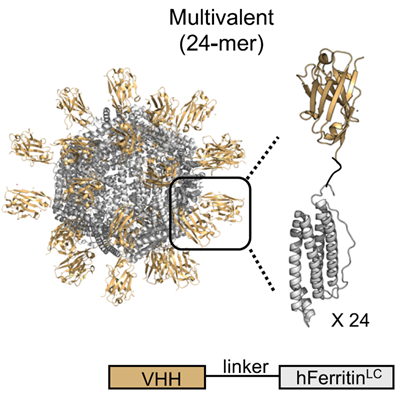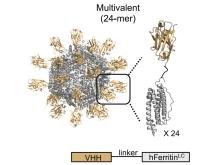BACKGROUND
Antibody therapeutic platforms have revolutionized modern medicine, offering targeted treatments for a variety of diseases. Conventional antibodies, such as IgG, are the most widely used forming a Y-shaped structure that allows for diverse antigen recognition and robust immune activation. These antibodies are employed in therapies for cancer, autoimmune disorders, and infectious diseases. However, advancements in biotechnology have led to the development of alternative platforms (e.g. bispecific antibodies, IgM antibodies, nanobodies) each of which brings unique advantages and challenges, expanding the possibilities for personalized and effective treatments. Herein, we describe a novel multivalent antibody platform that significantly enhances the potency of antibodies.
TECHNOLOGY
This innovative platform utilizes the human apoferritin protomer as a modular subunit to drive the oligomerization of antibody fragments. Apoferritin is a protein that naturally forms hollow, spherical nanocages composed of 24 polypeptide subunits. When a fusion protein is created from an apoferritin monomer and antibody or fragment, several fusion proteins can self-assemble to form a nanocage in which the antibodies or fragments decorate the exterior surface of the nanocage (Figure 1). By multimerizing these fragments, the platform transforms antibodies targeting viruses into exceptionally potent neutralizers, with up to a 10,000-fold increases potency compared to corresponding IgGs. This modularity also allows for rapid adaptation and evaluation against other infectious diseases of global health importance.

Figure 1. A multivalent nanobody (VHH) apoferritin nanoparticle composed of 24 subunits. The nanobodies decorate the surface of the nanoparticle.
COMPETITIVE ADVANTAGE
- Ultrapotent Neutralization: Achieves up to 10,000-fold potency enhancements compared to traditional IgGs.
- Broad Neutralizing Response: Combines multiple antibody specificities to overcome viral sequence variability.
- Modular Design: Allows for rapid adaptation and evaluation against various infectious diseases.
- Enhanced Bioavailability: Incorporates the Fc domain to improve bioavailability and therapeutic efficacy.
APPLICATIONS
- Infectious Disease Treatment: Adaptable platform for developing therapies against other viral infections.
- Biotherapeutic Development: Enhances the potency and efficacy of antibody-based treatments for various diseases.
INTELLECTUAL PROPERTY STATUS
- Three patent families (WO2019023811A1, WO2021016724A1, WO2023035056A8) at various stages of prosecution.
PROJECT STATUS
The nanoparticle platform has been developed and tested for various applications, demonstrating its efficacy in enhancing the delivery and therapeutic effects of antibodies and vaccines. The technology has been licensed to Radiant Biotherapeutics.
KEYWORDS
Nanoparticles, antibody, vaccine, therapeutics.





